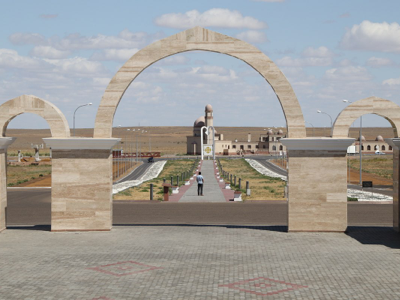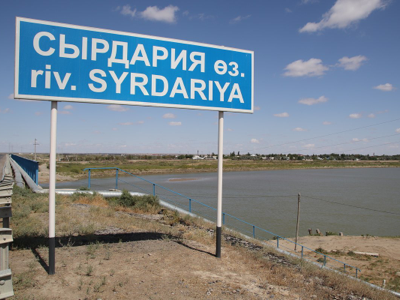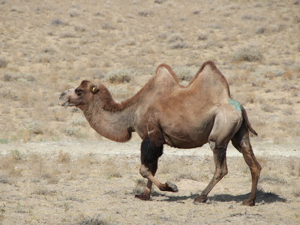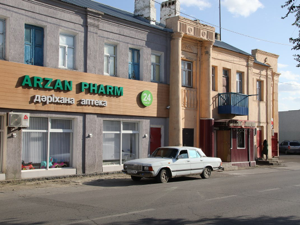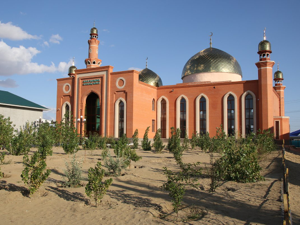Kyrgyzstan and Tajikistan 2018
Kyrgyzstan and Tajikistan 2018

Kazakhstan 2018
Kyzylorda may be the nearest airport to the Aral Sea in Kazakhstan, but it is still a long way away. Having completed the 930 kilometre flight from Almaty to Kyzylorda yesterday, today’s task was to complete the journey to the Aral Sea by road, a journey of a further 475 kilometres. Although the quality of the road is very good, the trip took all day, not least because my driver had to keep stopping for a cigarette or to buy bottles of energy drinks to stay awake on the flat, straight, monotonous road. If you have ever driven in outback New South Wales or western Queensland, you know exactly what today’s drive was like.
We left the hotel in Kyzylorda at a little after 10:00am, and drove. That’s basically the story of today. The countryside was flat, arid, and largely featureless, so I could understand why the driver needed to maintain his artificial stimuli; even I found the drive somewhat soporific.
Apart from the driver’s frequent cigarette stops, which I tried to encourage him to make beside interesting irrigation canals (even though they weren’t very numerous), we did make two stops for interest. Just south of the town of Zhosaly, the road crossed the Syr Darya, one of the two major rivers that feeds water into the Aral Sea. Parking is prohibited on the bridge, so I got out of the car, walked across the bridge while the driver had a smoke and a drink, and then got into the car again.
The second stop was somewhat bizarre. About ten kilometres beyond Zhosaly is a tiny settlement called Korkyt, which has just four buildings – a petrol station, a mosque, a roadside café and an architectural museum. The architectural museum is, to put it bluntly, not very architectural (from a merit perspective), nor is it is a museum. It was built a few years ago to honour a poet who was bitten by a snake and died while he was searching for eternal life; this apparently happened many centuries ago. Known officially as the Korkyt-Ata Complex (‘ata’ means grandfather’), it comprises a walled, elevated platform with a round amphitheatre in the centre, surrounded by square granite pillars with sloping tops, and to one side, a tall tower that collects the wind and funnels it through some pipes to produce some thoroughly irritating, discordant ‘music’. If the Korkyt-Ata Complex was your main reason for coming to Kazakhstan, I’d suggest visiting any one of 180 or 190 other countries first.
After wandering around the Korkyt-Ata Complex for, oh, several minutes, searching for doors or openings or hidden corners in the expectation that there MUST something more to the place (there wasn’t, unless you are fascinated by the abstract statue of a ram with huge testicles), we adjourned to a second of Korkyt’s buildings, the café across the road for lunch – surprisingly good value at $US1 for eggs with sausage, a bowl of hot locally baked bread and a large pot of green tea.
The drive continued with several stops for the driver’s physical needs, one of which was beside a photogenic herd of camels near the side of the road. Although we didn’t stop except to get a fleeting photograph of one of the tracking stations, we did pass by Baikonur, the cosmodrome where Russian spacecraft are launched. The actual launch site was a high security area around 65 kilometres to the north, but we had a good view of the township settlement and, as mentioned, one of the tracking stations.
We arrived in Aralsk at a little before 6:00pm. With a population of about 40,000 people, Aralsk (also known simply as Aral) is the administrative centre of the Aral region of Kazakhstan. It used to be a major fishing port before the Aral Sea shrank and the shoreline moved away to the south, leading to a significant economic decline for the town. Nonetheless, the town strikes me as more affluent than Moynaq, Aralsk’s equivalent settlement at the southern end of the Aral Sea in Uzbekistan that I visited twelve years ago in 2006.
The hotel in which I was originally booked, the Soviet-era Hotel Aral, has “closed permanently for renovations”, so I checked into the slightly newer Hotel Altair that is located outside the railway station, right beside the railway line. The rail line seems to be an especially active one, and for some reason, the Hotel Altair seems to mark the spot where passing trains sound their horns as loudly as they can. The good news is that the large open area at the front of the hotel, which serves as a drop-off point for rail travellers, is the town’s venue for local drivers to perform screaming wheelies in their Ladas, blowing their horns ceaselessly as they do so. Why is this good news? It’s because the cacophony of horn blowing is so loud that it actually hides the sound of moving locomotives that are right outside my window. And without going into too much detail, when there no locomotives going past and no car horns or wheelies outside, then the animal-like noises of the couple in the next room doing what seems to come naturally for an amazingly protracted period of time continues to disturb the solitude of my tiny space. They’ve been going at it for three and half hours so far...
I hope I am not coming across as overly negative about the hotel. It does have an official two-star ranking, and its internet seems to work well. The mattress is (very!) firm - I know because there are no sheets or blankets provided. There is electricity and hot running water, and the cake of soap supplied is several orders of magnitude larger than any other cake of soap I have seen in any hotel while travelling in Central Asia – which I hope will be helpful to cover up the pervasive smell of chicken manure that permeates the room (which might also explain why there are so many flies buzzing around).
After arriving at the hotel, I decided to take a walk into the main town centre which is a little over a kilometre away. This was a great experience, and even the town’s decaying, collapsing factories and decaying residential buildings with their exposed external gas pipes looked resplendent in the golden afternoon light. In the town centre, a large open courtyard housed an array of government buildings and a huge “I-heart-Aral” sign, while just off the main square a sensitively designed and impeccably maintained war memorial honoured the fallen in the Great Patriotic War of 1941-1945.
In beautifully maintained gardens in various parts of the city, images of ships and anchors allude to the city’s proud history as a port on the Aral Sea. Those days are now well-and-truly over, and I am looking forward to more driving tomorrow, though hopefully over shorter distances, to get a glimpse at last of the elusive waters of the Aral Sea.

Day 2
Kyzylorda to Aralsk
Tuesday
28 August 2018



